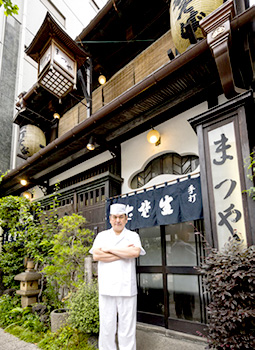Home > Highlighting JAPAN >Highlighting Japan June 2016>Living Heritage
Highlighting JAPAN


Capital Taste
Tokyo has an interesting variety of long-standing restaurants that remain popular not just for their delicious food but for the characterful buildings in which the dishes are served. In this article, we invite readers to two such iconic restaurants.
Dote no Iseya
The cooking methods of such representative Japanese foods as tempura, soba noodles, sushi and unagi (eel) were largely established during the Edo period (1603–1867) and are still closely associated with the Edo (now Tokyo) capital. It is common even today among Japanese people to go to restaurants to enjoy these four dishes because their successful preparation requires professional skills.
Established in 1889, Dote no Iseya was originally a three-story building. The restaurant was leveled in the Great Kanto Earthquake of 1923 and was rebuilt as a two story structure in 1927.
The restaurant took a long time off from business last year so that its walls could be repainted and other improvements made, yet hardly any of the regular customers recognized any difference in appearance after the work was completed. “Where did you repaint?” they asked.
“It was a major challenge for us to keep the refurbishment as subtle as possible,” Kikuo Wakabayashi, the fourth-generation owner of Dote no Iseya, says with a wry smile.
These days it is hard to find craftsmen who are experienced in renovating vintage interior decor such as wooden window frames and wood-latticed shoji sliding doors. Despite this challenge, the restaurant succeeded in keeping its classic ambience alive.
The restaurant building stands today just as it did almost 100 years ago, but its tempura has undergone a few subtle changes. For example, the main ingredients used for tempura used to be shrimps and conger eels that were freshly caught in Tokyo Bay. Vegetables used to be rare ingredients in tempura.
Wakabayashi says, “Eating styles and preferences for flavors inevitably come in and go out of fashion in response to the changing times. Tempura is no exception. When I took over the business as the fourth-generation owner, I started using vegetables as ingredients because more people are inclined to eat vegetables these days.”
Many people line up again today in front of the restaurant looking forward to experiencing authentic tempura and the distinctive atmosphere of a restaurant which on the surface at least seems to be stuck in a time warp.
Kanda Matsuya
It is said that there were more than 3,700 soba buckwheat noodle restaurants in Edo (now Tokyo) during the Edo period. Given that the population of Tokyo was around one million at the time, we can easily assume that soba was a very popular food among ordinary citizens.
Founded in 1884, Kanda Matsuya is a long-standing traditional Japanese restaurant known to every soba lover, and it is crowded with customers every day. On New Year’s Eve, for the tradition of eating soba noodles called “toshikoshi soba” or year-crossing noodles, Kanda Matsuya serves as many as 8,000 plates of soba noodles in a single day.
“I believe that soba is Japan’s representative fast food,” says Takayuki Kodaka, the sixth-generation restaurant owner. “We do not want to make people feel self-conscious about visiting our restaurant because of its time-honored status. We wish to always cherish an atmosphere that enables anyone to feel free to come in, like the soba restaurants did during the Edo period.”
Housed in a traditional Japanese wooden two-story building that was built in 1925 the restaurant seats sixty people. During peak times customers will usually be asked to share a table with those already seated.
In the Kanda area, where the restaurant is located, there are still some old restaurants that miraculously survived the firebombing of the Second World War. People come from far and wide to eat at such places, longing for the good old days of Japan.
“When it comes to renovating the restaurant or repairing its furniture, we always make sure that we use materials that match the original materials as much as we can,” says Kodaka. “We are committed to passing down the recipes and the significance of this historical landmark to future generations.”
© 2009 Cabinet Office, Government of Japan








